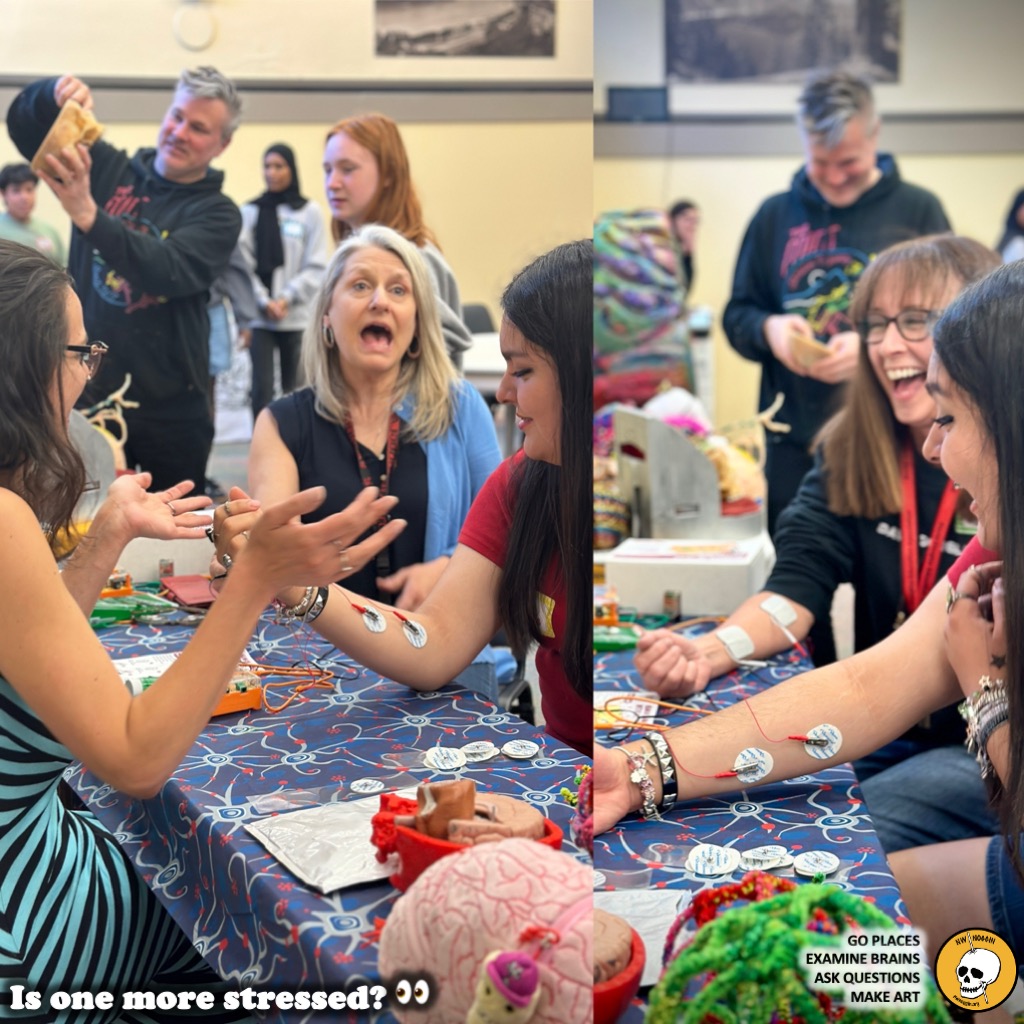Post by Melissa Garcia, an undergraduate at Portland State University pursuing a major Psychology with a minor in Interdisciplinary Neuroscience.

Why do I feel trapped in my mind?
Why I can’t escape myself?
Thoughts like these can impact people who live under pressure and face stress in their lives.
I’ve asked myself similar questions. During my first year of college, I procrastinated and filled my days with low-priority tasks. This distracted me from important academic goals and pressured me to put off everything until the last minute. When I encountered more personal problems the pressure provoked in me some chronic stress, with an array of negative outcomes.
During one of our outreach visits, a student asked me “why do we think too hard?“

That struck a nerve! I know that coping with a feeling of being overwhelmed is challenging. Before I attempt to answer why this occurs let’s look at how chronic stress might affect us.
How does stress form?
Stress begins when the brain and body respond to pressure.

That pressure can come from many sources, and we have unique responses to the demands of our environment. One person’s stressful stimulus might not be stressful for someone else.

But if you detect something stressful, a brain area called the hypothalamus releases a hormone called CRH (Corticotropin-Releasing Hormone), which triggers the pituitary gland to secrete another hormone, ACTH (AdrenoCorticoTropic Hormone!), into the bloodstream. ACTH then reaches the adrenal glands, where it stimulates the release of the stress hormones cortisol (a glucocorticoid steroid hormone) and epinephrine (also known as adrenaline).

This is known as the Hypothalamic-Pituitary-Adrenal (or HPA) Axis.
LEARN MORE: Physiology, Glucocorticoids
LEARN MORE: Physiologic and Pharmacologic Effects of Corticosteroids
LEARN MORE: Introduction to the Hypothalamic-Pituitary-Adrenal Axis
When the body experiences stress it also provokes a short term (or acute) alarm reaction by releasing catecholamine neurotransmitters, including norepinephrine. Stressors can be something you remember and reflect on (potentially involving activity in your hippocampus) – or something threatening you encounter that’s also detected by a nucleus in your temporal lobes called the amygdala.

The amygdala can generate MANY responses to stress. It directly activates the sympathetic division of your autonomic nervous system, and pressures you into a “fight or flight” mode. It also activates the HPA axis, releasing cortisol from your adrenal glands, putting your body and brain on high alert.
LEARN MORE: Physiology of the Autonomic Nervous System
Cortisol is important for our short term (or acute) response to stress, helping promote arousal, and marshaling energy resources for our body and brain. Cortisol levels naturally rise in the morning, helping us leave the bed and find the energy to face a new day!

However if cortisol levels are high for too long, or drop too low, there can be problems.
LEARN MORE: Positive upshots of cortisol in everyday life
LEARN MORE: Interactions between sleep, stress, and metabolism
LEARN MORE: Effect of cortisol on energy expenditure and amino acid metabolism in humans
Too much cortisol
Excessive stress turns into a chronic problem when the body encounters frequent, intense exposure to various stressors that keep us in alert mode, consistently feeling the pressure of stress over an extended time. This can lead to emotional exhaustion, or burnout.

“…chronically high levels can affect a number of different important functions. And it fuels the mental, emotional and physical exhaustion that comes with burnout…”
— Jessica Cohn-Kleinberg
Emotional exhaustion arises from prolonged stress, provoking fatigue, mood changes, depression, loss of sleep or too much time in bed and other unpleasant symptoms.
LEARN MORE: Emotional Exhaustion
LEARN MORE: Burnout phenomenon: neurophysiological factors, clinical features, and aspects of management
LEARN MORE: The Impact of Emotional Exhaustion on Psychological Factors in Workers with Secondary Traumatic Experiences
LEARN MORE: Emotional Labor and Burnout: A Review of the Literature
LEARN MORE: The Role of Cortisol in Chronic Stress, Neurodegenerative Diseases, and Psychological Disorders
Too little cortisol
Having lower-than-normal cortisol levels may also provoke physical and mental fatigue. Low cortisol has been described as adrenal insufficiency and, if provoked by autoimmune attack, it’s known as Addison’s disease. Chronic fatigue has been a contentious diagnosis, and some references are included below.

LEARN MORE: Symptoms & Causes of Adrenal Insufficiency & Addison’s Disease
LEARN MORE: Addison’s Disease: A Diagnosis Easy to Overlook
LEARN MORE: Adrenal fatigue does not exist: a systematic review
LEARN MORE: Chronic Fatigue Syndrome
Stress reduces dopamine
Lack of motivation or anticipatory excitement (also known as anhedonia) might also be linked low levels of the neurotransmitter dopamine, with individuals not able to seek long-term or even short-term goals such as leaving their own bed. Chronic stress can lower dopamine activity, which can reduce your productivity and participation in work, education, and life.

LEARN MORE: Dopamine System Dysregulation in Major Depressive Disorders
LEARN MORE: The effects of psychosocial stress on dopaminergic function and the acute stress response
Stress activates the amygdala
“Chronic stress increases fear, measured with conditioned freezing – a robust, and easy to quantify readout of amygdala-mediated fear.”
— Stress-Induced Functional Alterations in Amygdala: Implications for Neuropsychiatric Diseases
Under conditions of chronic stress, over-activation of the amygdala may also occur, causing fear, anxiety or depression. Long-term consequences can include panic and phobia to specific objects, situations or activities. Stress decreases the ability of brain areas involved in fear inhibition to quiet the amygdala, disrupting regulation and control over our emotional responses.
LEARN MORE: Stress-Induced Functional Alterations in Amygdala: Implications for Neuropsychiatric Diseases
LEARN MORE: Emotional Responses to Stressors in Everyday Life Predict Long-Term Trajectories of Depressive Symptoms
Are you just “lazy” – or emotionally burned out?
People often confuse emotional exhaustion with laziness, and based on my personal experience as an unenergetic person I wasn’t always able to make this distinction clear to myself either. Burnout is when you are impacted by environmental factors that result in physical and mental disorders that cause withdrawal and fatigue, while laziness is a conscious choice to avoid effort to perform tasks.

In other words, laziness is more of a temporary condition that might occur over a few hours or days while burnout is more persistent, with individuals losing motivation to perform any activities at all.
I think it’s remarkable that external problems impact us internally, and that life changes can cause bodily stress. And of course chronic stress itself can provoke additional problems such as mental and physical disorders. Chronic stress can lead, for example, to diagnosable anxiety and depression.

LEARN MORE: Neurobiological links between stress and anxiety
LEARN MORE: Different Areas of Chronic Stress and Their Associations with Depression
The “chicken and egg” idea (which came first?) illustrates how our problems and our stress operate.
Stress, for example, can trigger us into thinking too hard – but overthinking can generate more stress!
After reviewing the neuroscience of chronic stress, it’s clear to me that stress and overthinking are interconnected and intimately linked to our physical and mental health.

Stress can definitely cause too much thinking, excessive rumination, freezing, indecision and inaction, which itself will cause more stress, and more overthinking, and further reduces our capacity to handle stressful situations.
What can I do?
There are resources available to help individuals survive chronic stress and even reset their bodies after being exposed to stress for extended periods. Each method has a focus on either healing the individual or addressing stressful aspects of the environment. As certain factors can generate chronic stress, it’s important for us to recognize what they are and how to take care of our bodies, and our brains.

LEARN MORE: Reducing chronic stress to promote health in adults: the role of social prescriptions and social movements
LEARN MORE: Resilience in the Context of Chronic Stress and Health in Adults
MAKE ART
ART is linked with several benefits for people experiencing chronic stress.

Art making can reduce both stress and overthinking. Making something is often engaging and creative, and could takes your mind off your concerns. Art offers an opportunity to express our emotions through what we create. It can be a form of self-care.

LEARN MORE: Creative Arts Interventions for Stress Management and Prevention—A Systematic Review
LEARN MORE: Reduction of Cortisol Levels and Participants’ Responses Following Art Making
LEARN MORE: The Connection Between Art, Healing, and Public Health: A Review of Current Literature

I appreciate Northwest Noggin for introducing so many opportunities for students to engage with our community in spreading neuroscience. These visits were enjoyable as we discovered and learned new topics. And interacting with others and creating art improved my emotional state!


